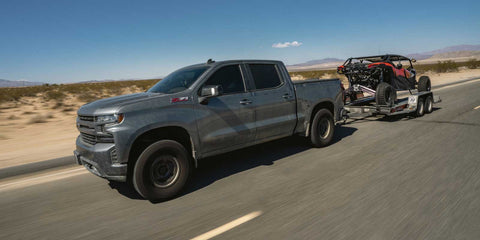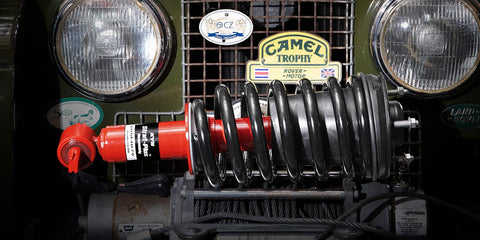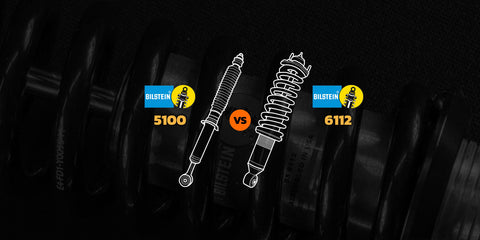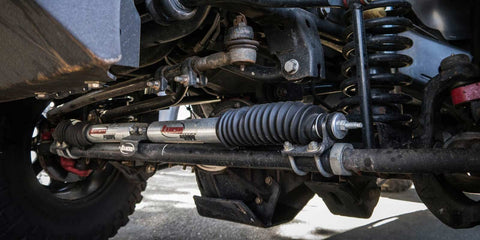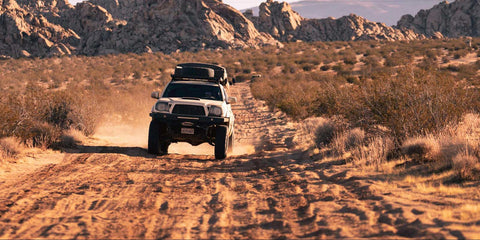Icon 2.5 Coilover Shocks - 2022 Bronco Ride Review
Posted by Sean Reyes on
In This Article
In case you are new to the Shock Surplus party, we make it our business to test the gamut of aftermarket suspension systems on our own rides and rigs so that we can provide real-world reviews backed by actual experience to help cut through all the marketing malarky these brands love to feed us.
Our 2022 Two Door Badlands Sasquatch Bronco (a mouthful, I know) is certainly no different, with these Icons being the fifth set of shocks it has seen since assembly in Michigan. If you are looking for a more complete review of each option we have run previously, you can hop out here and take a look at those, however, here is a brief synopsis of the road as of yet.
digressive [ dih-gres-iv ]
adjective
- A type of shock tuning strategy that starts out stiff at slower shaft speeds, as speeds increase the stiffness tapers off. A digressive shock sometimes givess a harsher ride quality due to being stiffer at slower shaft speeds but comes with the advantage of increased vehicle control. Stability is gained because it takes a lot of the body roll out of the vehicle, which enhances corning ability.
- tending to digress; departing from the main subject.
HOSS 2.0 ESCV
Being a Badlands model, our Bronco was guaranteed a set of End Stop Control Valve 2” body Bilsteins as standard, however, the Sasquatch package did award us with a slightly different shock and spring to the standard Badlands models, albeit with a nearly identical tune. To guarantee your fenders are free from attack by the factory “35” inch Goodyears, Sasquatch models sit a little higher and have a little less upward suspension travel, however, from what we have seen; the ride feels pretty darn similar to a regular Badlands.
As far as stock suspension systems go, these offer some of the best performance for high-speed off-road driving we have seen to date. That is to be expected, though, since it is in the name. Right out of the box we could fly over moderate whoops at speeds that really should not be possible on a stock rig, and that all comes down to their End Stop Control Valve design. That is not to say they are anywhere near perfect, even when they are in their happy place. Although the internal jounce stops kept us trucking better than any 2” body shock should, we found that they were engaging a little too often, causing it to feel like we were just ping-ponging from stop to stop. In the rear, we also found that the engagement of that stop was a little too abrupt, so when the Bronco was boogying through the bumps, the back end certainly had a penchant for getting out from underneath you so that it could swap ends with the front. (RIP Johnson Valley Bush, you will be forever missed). We’re sure the short wheelbase amplifies this, however the feedback isn’t much different from the four-door guys.
When speeds decrease or when the dirt turns to asphalt, these dampers certainly feel far from their happy place. Although the ESCV design certainly does wonders for overall support, there really is no way for a 2” body to keep you from bucking through big bumps as well as they do without making some sacrifices elsewhere. In this case, that sacrifice comes via the way of being just plain stiff over small bumps at lower speeds off-road, and just about everywhere on the road. Where it was all party and no problems flying through the desert, we really thought these shocks were going to rack up a fortune in debt in filling replacements and chiropractic work after a few miles on a forest road. We are all about control over comfort, yet even with our high tolerance for stiffness, these shocks began to get on our nerves.
Bilstein 5100
Probably the biggest surprise of the bunch, the Bilstein 5100s felt like they slotted in as the perfect shock for the average driver on a tighter budget. We expected these to feel just as firm as the stock parts in their normal ride zone with a fraction of the bottom-out support and were certainly right on one front, but we were pleasantly surprised by how much more comfortable and livable they were compared to the stock Billies. Where chatter from a washboard road or the hard thud of expansion joints on the highway felt like they were rattling your brain with the standard ESCVs, the 5100s would all but float right on through. You may still feel those little inconsistencies through the seat of your pants, but it is more than livable, to say the least.
The lack of the internal stops also allows the 5100s to be far more predictable and easier to drive at their limit, which, unfortunately, is a whole lot lower than stock. Selling shocks for as long as we have, we are aware that that may not matter for the vast majority of drivers, however if you like to party, these are not for you.
During our high-speed testing, we became comfortable with the god-awful sound and sensation of running out of travel in both directions. They never felt like they were truly fading all that badly, but they were definitely holding us back. That is where we think the 6100s or 6112s will slot in perfectly, providing a huge bump in comfort for more sane use, and the additional support you need to let loose or save you when an obstacle sneaks up on you. That is a tale for another day, though.
Icon 2.5 EXP
After our foray with some stock diameter shocks and stock-sized tires, it was high time for us to step up in both departments. With these rigs rolling out of the factory with just shy of a 35” tall tire as standard, we knew just like us, many of you would be ready to step up into 37” tire territory. Icon’s release of their new 2.5 EXP coilovers felt like the perfect opportunity for us to take that leap. 37s are big, tall, and heavy, so fitment and being able to control that added unsprung mass was definitely a concern. We will touch on the foibles and frustrations of a tire that big later, but suffice it to say that these new Icon johnnies did a killer job.
Icon Shock offers a stunning collection of visually striking icons that captivate and engage. Elevate your designs with a touch of brilliance from our diverse catalog.
So what the heck are Icon EXPs?
Similar to a Bilstein 6100, these EXPs are circlip adjustable 2.5” body coilover that allow you to lift your Bronco between a few select settings while retaining the stock springs. They do require some minor modification to the top hats on all four corners, which we definitely were not stoked on, but are otherwise a simple and mostly bolt-on upgrade that made a world of difference. By no means are they cushy, but they are a heck of a lot more plush over the smaller stuff than stock, while being able to fly over the big stuff off-road without a care. It will not turn your Bronco into a trophy truck by any means, but the combination of the bump in body size and travel really does allow you to get away with more than it feels like you should. They may not be for somebody who wants to drive a pillow, but they are comfortable enough to live with every day while still giving you the support to send it if you are so inclined.
If you follow us on Instagram, you may have seen we had a little bit of a mishap where one of these shocks exploded on us, however, they were early production parts, and after investigation, it was found just to be an issue with IFP depth. This, without getting too technical, is such an easy flub to make that the same thing could happen on just about any brand's shocks. We will definitely be doing a deep dive on this at a later date, but suffice it to say we do not hold it against Icon, and neither should you. In short, if this is as far as your budget will get you, and you like to push the limits off-road, they are a killer compromise.
Eibach 2.0
After the broken shock fiasco, we needed a solution post haste, and Eibach was able to get us their Stage 2 2.0 coilover kit in less than a day. We definitely were not excited to step back into the lowly realm of 2” body shocks from our 2.5” body high horse, but with the good luck we had testing their parts on our other rigs, we were cautiously optimistic. As always, Eibach was able to punch well above their weight class with a setup that occasionally had us questioning how they were able to extract so much from so little piston surface. The operative word there being “occasionally”.
Overall we found them to have a surprisingly sublime balance of plush and supportive tendencies pretty much everywhere. In fact, unlike either of the 2” body Bilsteins we ran previously, I do not think I felt them bottom out harshly once. They did a great job of keeping the Bronco floating on top of the bumps, rather than smashing into them; a big factor to why you might be able to push these a lot harder than any other 2” body shock we found. When not being totally overwhelmed by unsprung mass, they seem to be even more plush over smaller bumps and chatter. This is to be expected considering they use a linear piston versus the digressive design Bilstein uses.
What did take us by surprise was just how loose they felt, particularly in the rear. From a lot of body roll around corners to the rear end coming completely unloaded under heavy braking, it was hard to trust how the Bronco would react in any given situation. On the limit, it would quickly transition from understeer to snap oversteer at a moment's notice, which is definitely a sign of the lack of control over weight transfer in the chassis. In Eibach’s defense, Ford started sprinkling in rear sway bars into the select models starting in 2022, so there is a good chance they did their testing on a Bronco with a rear bar. Ours was not blessed with that luxury, so it could simply just be a mismatch for our particular application. With that said, they did seem to use an excessive amount of travel over long rolling bumps, so they definitely may feel a little light in the low-speed compression department, even with a sway bar.
Another complaint that you can’t really fault Eibach for: these shocks just could not keep up with a 37 inch tire and unfortunately they allow for enough bump travel to buzz your fender flares when they bottom out. We found that the dampers were often totally overwhelmed by the tires, even on the road; it was not uncommon to feel dribble rolling down the highway. Eibach tells you this package was optimized for 35s, which certainly seems to be the case. Over harsh chatter, it often felt like the tires were riding on air more than they were on the tarmac or trail, which was not confidence-inspiring. We believe this is where the 2” body becomes a limitation. To get the performance Eibach was looking to achieve, they likely had to narrow the window of effectiveness on the shock, so to speak. So the pop-off valving that kept the Bronco tip-toeing over the top of the big bumps on a 35” tire or smaller also meant they would bounce a tire as heavy and big as my 37s. We surmise if you keep the combined wheel and tire weight below 110 lbs or so per corner, these Eibachs would work great. However, the thick, tall, and heavy (125 lb) Maxxis Razr MT tires mounted on stock wheels are way too much for these little guys.
So What’s the Deal with the Icon 2.5 IRs?
Icon is probably best known for their complete suspension systems, and these 2.5 IR coilovers would be the coilovers included with their Stage 3 kits. In fact, with the addition of the Tubular Delta Joint Pro Upper Control Arms, we have exactly that. These coilovers are a true 2.5” body monotube design with no external reservoir, which we think is just about as much shock as the average person may need. Truthfully, most of the time we recommend a 2.5” body shock with a remote reservoir to our customers, it is because of the dampening adjustment the design allows for and not necessarily for the additional heat dissipation. The average person hardly drives their rig hard enough to overheat a 2” shock but certainly needs a lot more dampening force than a 2” body can offer without having a tune that makes serious sacrifices in ride and handling. A 2.5” body will be more comfortable, more supportive and make a heck of a lot fewer sacrifices in tuning for a greater effective range of performance. Put simply, since the shocks do not have to work as hard, they don’t work you as hard when you are driving it. Plus, with how easy it is to throw 37” and bigger tires on these Broncos, we really think most people are going to need the additional dampening force.
Icon 2.5 IR Dimensions and Fitment
Without a doubt, these Icons cycle the most travel of just about anything we have seen specifications on or tested so far. They will bring your Bronco up to just over 11” of travel in the front and 14” of travel in the rear. Part of how they are able to do this is by having the longest extended length that will fit without breaking parts, with one of the shortest compressed lengths on the market.
You definitely are not getting away with the stock front upper arms, and you should probably be upgrading your rear links as well. Normally such a short compressed length would cause a serious concern with keeping your fenders intact if 37s are on the horizon; however, Icon offers bump stop spacers specifically designed for these coilovers that slide right on and keep your flares safe. In our opinion, we think this is the most elegant and well-thought-out solution for making 37s work, as they give you all the travel you can possibly cycle on a 35” tire or smaller while also giving you an easy fix if you are inclined to run bigger meats.
Fox and some of the other coilover options do not give you the choice. They run an extra long compressed length on the body to limit travel no matter what. We really think Icon did it best as nobody has to sacrifice travel. In our case, we just let them suckers self-clearance.
Another place where Icon worked its magic to extract that little extra bit of travel is at the upper rear mounts. Where the factory (and most aftermarket systems) mount below the tower, the Icons actually run the coilover through the tower and mount from the top to allow for the longest coilover possible for the most droop travel without any sacrifice in bump. 14” of travel is certainly a big number, and although their packaging certainly helps them fit, these were the first coilovers that actually pushed the factory links up to and beyond their limit. To be able to bolt up the lower mount it took two of us hopping on the axle to get the lower trailing arms to flex enough to allow for enough droop to get the coilover installed. That amount of bind will not harm the factory links or track bar whatsoever. But, if you really want every inch of that 14” of vertical travel, you will need to upgrade your lower trailing arms at least. If you truly want ALL the flex and articulation these have on tap, you should be doing the uppers and track bar as well; none of the stock joints have enough misalignment to keep up.
How Do the Icon 2.5 IR Coilovers Handle?
Normally we do not make a huge stink about handling dynamics on these suspension systems as most are an improvement, at least in stability, compared to the stock parts regardless of ride height; however, these Icons were phenomenal in that department. Of course, any off-road-oriented vehicle will have some sway, but these Icon coilovers were the most locked-down set we have tested so far. Brake dive was almost completely eliminated, and were stable enough for us to confidently hang a front tire around corners without sweat. They would progressively gain sway through long corners; however, any body roll is so minimal it is still easy to manage. What really made them feel special was their ability to take bumps through direction changes without upsetting the chassis. There were many times we were full throttle and lit to the lock stops through corners, and even if a bump sent one or all four tires airborne, the Bronco never skipped off line or got out of shape. They may be prone to a little more understeer than we would like, however, a lot of that could be chalked up to the combination of spring rate and our lightweight little four-pot. A 2.7 four-door Bronco, or one with a little more weight up front than we have on ours, will likely turn in better. With that said, a little bit of understeer does make things a little safer for inexperienced drivers, especially on a rig with such a short wheelbase.
Icon 2.5 IR Coilover Ride Quality
Our Bronco is a two-door 2.3 with a manual transmission, putting it on the lighter side of the spectrum. Icon optimizes their spring rates and valving for a little extra weight from items like aftermarket armor and your typical overlanding gear, so we had a slightly stiffer experience than the average Bronco. With that said, you can certainly expect these to be more comfortable and predictable than the stock HOSS 1.0 and 2.0 suspension systems.Street
On the road, the ride was more akin to a BMW M car or a Porsche GT car than an off-road rig… even with the 37s. The ride is firm on most accounts but more than compliant enough to live with as a daily driver and it handles without most of the gripes we had with the stock suspension and some other suspension systems we have tested so far. As we said, these are sprung a little firm, so the weight of an aftermarket bumper or even a V6 and 10-speed may be enough to eliminate that small amount of harshness as well. Although we could still feel some road harshness, they are a big step up in that department over the stock dampers, and some of that firmer feel could be attributed to the tires as well. Speaking of which, gone was the tire dribble and instability over bumps we felt with the Eibachs, thanks to the big 2.5” body design having the damping force to actually cope with the additional unsprung mass of those 37s. In short, these Icons allow your Bronco to pretty much drive like a regular car, even if it is rolling on big tires and sitting sky-high off the ground.
Off-Road
As you might expect with any 2.5” body off-road oriented coilover system, these Icons really come alive when the pavement falls away. They certainly feel very “Digressive”, so you are going to feel the little stuff at low speeds, but boy can they boogie. They are definitely a shock you will want to drop your tire pressures for when the tires touch dirt, but anytime they felt firm for us, we just drove faster, and they really “opened up.” Just like Icons dampers for other applications, the faster you go, the more forgiving they get, so if you like to drive fast, these will certainly reward your efforts. Usually, a digressive shock will use more travel over bigger hits than something linear in valving, however, we never once felt the Bronco buck or bottom-out harshly, and we think a lot of that comes down to the great set of bump stops Icon specced these shocks with. Or maybe it was just because they had more travel than everything else, but either way, if you like to drive at the limit, you’ll like these shocks. In fact, even without external reservoirs, we never noticed any serious fade, although as hard as we drove in our testing, we never did any extended runs to see if we could truly find their limit.
Those big travel numbers will not only help you out when you are floating your rig through West Coast whoops and washes; the additional travel we gained really had us almost forgetting these 6th Gens don’t have a solid front axle. Sure, it would still Yota Wave on occasion, but now the Bronco really made us work for our “three-wheel motion” pics for social media. As we said, they did feel a touch firm at those lower speeds on trail, however, if you have some extra weight in armor, accessories, and or gear, we’d wager these would feel aces. Besides, once you are lifted, and on big tires, you’ll need a bumper and winch to ensure your buddies can make it through all the hard trails you’ll be dragging them down.
Bottom Line
On something without dampening adjustment, it is impossible to make a shock that is perfect for everybody. But, if you like something firm, like to roll out fully-loaded, or have a lead foot, you will really like the Icon 2.5 IR Coilovers. In fact, if this price point is where our budget landed, these would likely be at the top of our list. Although our Bronco is somewhat light and largely unladen, between our aggressive driving style and preference for control over comfort, these tick more than a few boxes on our shortlist of requirements. That said, we know many of you would rather simply cruise your Bronco through the woods, to work, or to the kid's soccer games and are keen on a softer, more compliant ride as a result. If your driving style and preferences for ride comfort are on the more benign side of the spectrum or you do not see any serious additional constant load in your Bronco's future, these particular Icon coilovers may not be for you. But if you like to party off the pavement or your Bronco has packed on a few extra pounds, you will probably get along with these Icons quite well.

